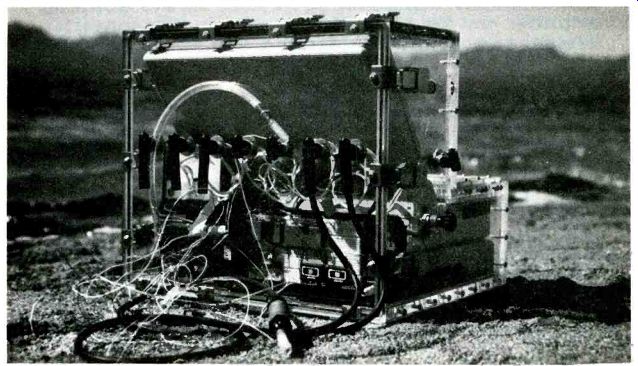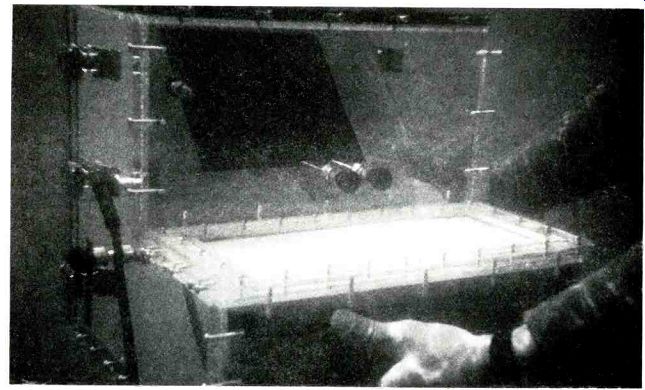Courtesy Ian Bruce, Senior Technical Marketing Engineer, ANALOG DEVICES, INC.
Isolation Amplifiers allow investigation of animal "Sixth Sense." Generating very low-level signals to mimic animal electric fields requires careful design and isolation for success.
Engineers in everyday life aren't generally requested to investigate the sex lives of fish. They are, however, often required to generate, simulate or transmit low-level signals across large distances in harsh environments. The following short article describes an unusual and demanding application for digitally synthesizing very low-level signals in salt water.
Researchers have discovered that stingrays, sharks and related animals possess a "sixth sense," they are able to perceive electric fields. To discover if they use this ability to detect potential mates required precisely simulating the tiny nanovolt-per-meter field generated by these animals under water. This article explains how scientists, using Analog Devices' AD210 isolation amplifier and the AD 7845 digital-to-analog converter, designed equipment to generate, isolate and transmit such signals.
It may not be animal magnetism, but stingrays and other fish do seem to have an attraction for one another that is truly electric. Researchers have shown that sharks, rays and skates (known collectively as Elasmobranchii) possess a sixth sense: they are able to perceive electric fields. Small receptors called Ampula of Lorenzini can detect the minute electric field generated by all animals, including humans. Sharks use this ability to hunt and capture their prey.
Researchers believe that other elasmobranch behaviors can be attributed to electric field detection, including mating. Romantic male stingrays are thought to find a "relationship with potential" by sensing a potential difference. Female rays, buried in sand during the mating season, produce a characteristic electric field associated with their respiration.
An electro-chemical voltage exists between the mucus membranes in the animal's mouth and surface membranes distributed around the gills (the mouth is at a negative potential with respect to the gills). The distribution of the gill membranes produces a complex, multi-pole field around the ray, and the field intensity varies as its mouth opens and closes. Male rays in the area sense this and, their interest sparked, come like a flash to the buried female.
To test this theory, Dr. Timothy Tricas, Research Associate at Washington University School of Medicine, designed a system that could record then replay the electric calls of female rays. With the help of Scott Michael, graduate of the University of Nebraska, he located a colony of Round Stingrays that mate in shallow water near Baja Kino off the Mexican Gulf coast.

FIGURE 1. Mimicing Stingray electric fields required careful design
and isolation. Shown is the AD7845 multiplying DAC used to generate the
harmonic electric calls and the AD210 isolation amplifier, both from Analog
Devices.
The experiment presented a number of interesting technical challenges common to applications where complex, low-level signals are being reproduced.
Rays generate a very weak, dc electric field modulated with a fundamental frequency just below one Hertz. The mean intensity is only 500 nV/m (by comparison, the mean field intensity of the earth at sea level varies between 100 and 300 V/m, and can rise to 10,000 V/m during electric storms). Mimicking female Round Stingrays requires accurately reproducing this low level signal in seawater at a depth of several meters, and in such a way that the complex spatial domain of the field is retained.

FIGURE 2. The computer and its associated equipment is shown housed in
the water-tight plastic enclosure at the Mexican experimentation
site. Visible are the blue Analog Devices' AD210 isolated amplifiers.
The harmonic bio-electric calls generated by female rays were stored on the hard disk of a Compaq laptop computer. For playback, the PC was connected to a plug-in digital-to-analog interface card, which in turn was connected to Analog Devices' isolation amplifiers. All of the equipment was enclosed in a water-tight plastic enclosure designed especially for the project (see Figure 1). Sealed connectors linked the output of the isolation amplifiers to remote silver electrodes.
To better understand what properties of the electric field "turn-on" male rays (do they like their fields to come on strong and heavy, or are they more interested in racy, fast signals?) both amplitude and frequency were varied. Frequency control was maintained by the computer, and the intensity of the field was varied using multiplying digital-to-analog converters (DACs). Multiplying DACs have two input variables: a digital word corresponds to the playback of the female ray from the computer, and an analog reference voltage determines signal output magnitude or intensity. Using Analog Devices' AD7845 12-bit DACs, the output current to the isolation amplifiers could be controlled accurately in the 4- to 8-uA range. This produced electric field intensities in the nV/m range near the electrodes.

FIGURE 3. The computer is submerged to several meters and ready for connection
to the electrodes.
Isolating the output signal from the battery power supply and ground was essential. Analog Devices' AD210 isolation amplifier was chosen because it combines high 2,500 V isolation, low ±25 ppm/°C gain drift and 120 dB common mode rejection in a small, 2.1" X1.0" X0.35" package. It could also operate directly from the unregulated 12-V PC battery.
Isolation amplifiers galvanically isolate both the signal and the power supply, interrupting ground loops and leakage paths, and rejecting common-mode voltage signals. Without such isolation, noise and common-mode signals would have distorted the uA output significantly, and the computer's calls would have been unrequited.
The output of the isolation amplifier was fed to a pair of remote silver wire electrodes which are the substitute for the electro-chemical membranes of the ray. To enhance the realistic orientation of the electric field, the wires were formed and separated by a dielectric plastic sheet. All cabling was buried from view. There were no visual, audible or olfactory clues to the presence of the hidden electrodes; they could only be sensed by the electric field they generated.
Dr. Tricas conducted his experiments in the Spring of 1990, and the results have been filmed for a National Geographic special that will air in 1992. Male rays that passed within a few meters of the buried electrodes were attracted by the emitted electric field, and tried in vain to unearth possible mates.
Interestingly, female rays were also attracted by the signals, and buried themselves close to the electrodes.
More research is required as to how elasmobranch and other animals use their sixth sense.
Researchers speculate that electric fields generated by animals moving through the earth's magnetic field may be used to detect heading. In ancient China it was believed that catfish had precognition of impending earthquakes; scientists now know that prior to quake activity there are large variations in the earth's electric field, which some animals may be able to detect.
Also see:
Build An Audio Tape Noise Limiter
adapted from: Electronics Handbook 1992